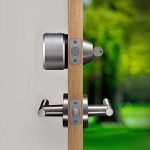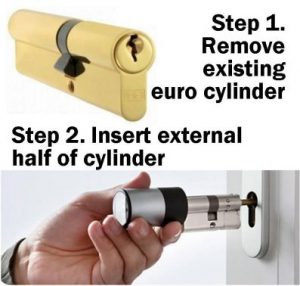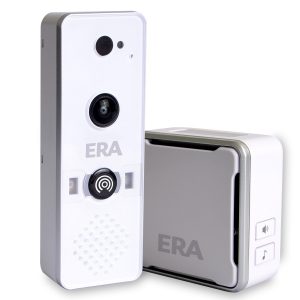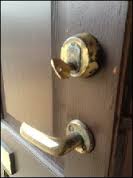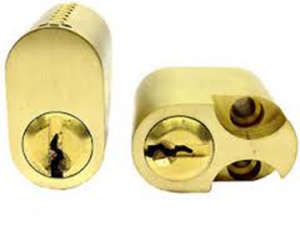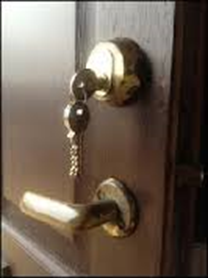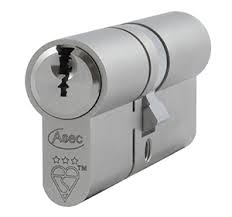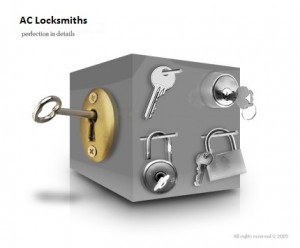It is well known that business properties, especially where the public has access, should have secure fire exit doors, which means that all locked doors should be able to be opened from the inside without a key.
But many people renting out properties for holidays do not realise that these fire exits should have easy escape capabilities. The logic behind this is that if the lock is key operated on the inside, the customers may well lock the door, put the key somewhere safe, and then should the worst happen and a fire break out, in their panic and being away from home, they could well forget where they have put the key and be caught in a tragic accident.
So if your wooden door has a nightlatch (often called a ‘Yale’ lock), and that lock has a British Standard Kite mark, you are fine.
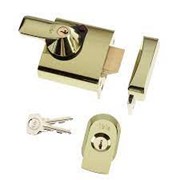
If your wooden door has a mortice (often called a ‘Chubb’ lock), with key operation on both sides, there is a conversion that can be done to use a Euro Cylinder that has a thumb turn on the inside. This means changing the lock and handles but can use the existing space with minimal visible change.
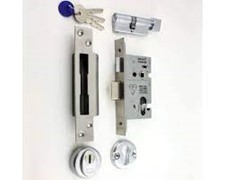
If your door is UPVC or has any mechanism where the handles must be lifted before locking, it is a simple matter of swapping the existing Euro Cylinder for one with a thumb turn on the inside.
This is a key both sides Euro Cylinder: 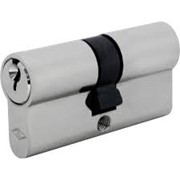
And this is a standard thumb turn Euro Cylinder: 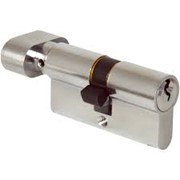
There is a slight worry with installing these fire escape systems, though and that is I have a tool that can go in through letter boxes and turn the thumb turn allowing me access to the property. We have two solutions. Firstly, certain thumb turns on the very best cylinders are designed to be difficult for tools to turn. They might require a push while turning or just plain difficult for the tool to purchase.
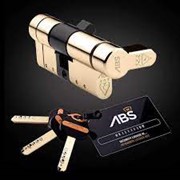
Alternatively, you can buy specially designed sloped guards for your letterbox (although even these can be bypassed with ever more clever locksmith tools).
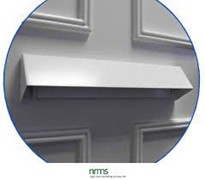
Or better yet a letter catching cage on the back of your door will stop all tools that I know of at time of writing.
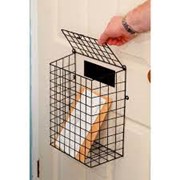
If you own or run holiday lets, you might find your public liability insurance does not pay out if you have not taken the correct measures to ensure the safety of your guests.
I am noticing a lot of village halls are also suddenly finding out from fire inspections that they are not up to scratch. Please check the regulations specific to you if you run any property that is not a private home.
Click here for Government guidance on fire doors/fire safety
Should you have any questions regarding the above information, please do not hesitate to contact me.
Thanks for reading.
Changing the locks on a brand new property
There seems to be a massive drive to build new homes lately. Almost everywhere you go, you are bound to be driving past a new build construction site. You might even be looking at a nice newly built home in your area, or even bought one. The beauty of a new home over an older one is that you can move in knowing you have nothing to do. The carpets are already fitted to your criteria, the sparkly kitchen gleams and there is no worry that some random neighbour has a spare key to your home, so why are we advising changing the locks on a brand new property?

Why change the locks?
Quite frankly, the developers will do the minimum possible to meet regulations, and currently in the UK the regulations just are not up to the same level as the burglars. New homes are all being built with multi-point locking mechanisms and while all the hooks, bolts and rollers look impressive and secure, the system is only as good as its’ weakest part, which is the locking cylinder. While standard locking Euro Cylinders are acceptable for insurance purposes, they are incredibly weak to a form of attack called ‘cylinder snapping’. Property developers will use these standard cylinders wherever possible.
Some of the more reputable developers will at least have the decency to install kite marked Euro cylinders in their doors, but beyond the kite mark, there are still three grades of security, which cover the three main forms of attack, those being snap, pick and drilling. So a cylinder with one star will be proof against picking but not the other two, and a cylinder with two stars will still be susceptible to attack by one of the three main methods. You can supplement the star rating by having anti-snap collars placed inside the handles, or anti-drill handles. You may even have these, but if you don’t know, then the burglar doesn’t know either and he is likely to have a go, fail and leave your door a mess before he leaves. Only a three star cylinder should be used if you want the burglar to go away before even trying.
With total honesty, there is a tool that can be purchased to bypass even some of the best three star cylinders, but it takes time use and is fiddly. Entry with this tool is trial and error, sometimes taking many minutes to get in the door, whereas a standard cylinder can be snapped in under 60 seconds with household tools and no sound. For the same reason a burglar will not take the time to remove your roof tiles and enter that way, he will not purchase a tool that takes him many times longer to get in than the cheap tools he can get from a DIY store.
Cylinder snapping is no longer about normal burglary any more; Intruders know that most people leave their car keys somewhere in the vicinity of the front door, be they left on a surface, hanging on a convenient hook, or just in a coat pocket. They can now look for the car they want to steal parked nicely on your front drive. As most of us are now two car families, at least one will sit on the drive, and if that car is your brand new Mercedes or BMW and you keep your keys close to an easily attacked door, your insurance might decide not to pay out because you didn’t take enough care. How many people tell their insurance the car is kept in the garage, knowing that actually the garage is full of the toot we don’t want in our actual houses? Breaking into a house and stealing the keys is now the easiest way to steal their car.
And while a barking dog is a deterrent to some degree, what protects your home when you are on holiday or even out walking that dog?
Most three star Euro cylinders are visibly different to standard cylinders. They shout at the burglar you are serious about home security and that attacking your home is going to be noisy and time consuming. Noise and time are the enemy of the burglar. If he knows breaking into your home is going to be noisy and take up precious time, he is going to move on. If you fit the proper cylinders, chances are you will be angry with the locksmith after years and years of never seeing any signs of attack. You will never know how many intruders scouted your home and mentally noted to leave you alone. It’s not hard. I help my kids with their paper round, and the best locks stick out like a sore thumb. I know exactly how few there are and where they are. A potential intruder only has to deliver some bogus leaflets in any area to work out who is best avoided.
While on this subject, an emailed question asked if it worth putting extra strength glue in an externally beaded window so that if the burglar got the beading off the window would still be stuck in place. Beading removal was never a hugely popular method of attack. There was always too much potential to make noise and take a long time. Also, the risk of breaking glass and then cutting oneself is too high, even without extra glues. Cylinder snapping is quick, quiet and easy. So faced with a choice, you should always upgrade your cylinders.
If you have standard cylinders or even kite marked one star cylinders, you should upgrade now. If you don’t know what you have, a good locksmith in your area will come and assess your locks via a free security check. Unless a locksmith has provided your locks, I very much doubt they will be the best on the market. You cannot buy the best locks in the DIY shops. While you are ensuring you have the best locks, you should be sending a copy of this information to everyone you care about, because of the following reasons:
- Burglary is on the rise.
- Traditionally ‘safe’ areas are being burgled more often.
- Only a tiny fraction of burglaries get investigated by police.
- You are now at risk from car thieves as well.
- Burglars pass on information to each other, so if you are burgled once, you stand an increased chance of being hit again.
- Every person I speak to who has experience a burglary, reports feeling of personal violation, sleepless nights and detachment from their home.
If you have any questions regarding the above information or any of the other blogs I have written, please get in touch via any of the methods on my contacts page.
Thanks for reading.
New build Holt, New build Fakenham, New build Aylsham, New build Cromer,
New build North Walsham, New Build Norfolk, Locks Holt, Locks Fakenham,
Locks Aylsham, Locks Cromer, Locks North Walsham, Locks Norfolk
What I have learned after 10 years as a Locksmith?
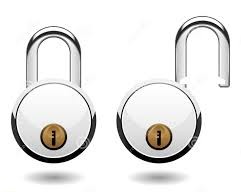
Lessons 10 years as a locksmith has taught me:
1. The multipoint locking mechanism on a double glazed door (or any door where you lift the handles before locking) is NOT a five lever lock. Five levers refers to the internal levers in a mortice lock which sits inside a wooden door.
2. All of those hooks, bolts, mushrooms, and rollers on a lift handle door mean nothing when burglars can attack the lock barrel easily. Having the correct barrel is vitally important and while you might get the insurance company to reimburse your financial loss, they cannot replace the heirloom given to you by Grandma that has enormous sentimental value. If your locking barrels do not have British Standard kite marks, you are practically inviting burglars into your home.
3. Home security is not necessarily about keeping intruders out. We all know they can smash a window. But they do not want to leave through that window carrying your stuff. You are looking to make it as hard as possible for them to leave with their arms full.
4. Look at your neighbour’s house when thinking about home security. Your aim should always be to make them look like an easier target. Crunchy gravel, CCTV, alarms, sensor lights are instant barriers before they even reach your door. Burglars recognise good locks and will go elsewhere. Your local locksmith knows the best brands you can’t buy on the high street.
5. That sneaky place you hide a spare key in the garden is glaringly obvious to the burglar. You are much better off with a quality keysafe.
6. You do not need multiple keys for carers. A keysafe can be much cheaper and easier for all. No more worries when keys go missing.
7. A home safe is not just about deterring criminals. A good one will protect important documents in the event of a fire. But batteries should be changed annually whether the low battery warning beeps or not, and override keys should be kept with a trusted neighbour or family member. Leaving the keys inside the safe is not a clever idea.
8. Taking your car on holiday? Make sure your partner takes the spare key. Nothing worse than calling a locksmith to open your vehicle when you lock the keys in the boot knowing a spare key is at home. Do not leave the spare key in the glove compartment.
9. Very few smart locks conform to BS3621, meaning they are not covered by your insurance.
10. Most lock failures can be avoided. If you notice your lock is getting harder to operate, or you have a special knack for opening the door, then something is wrong and needs addressing. It will be cheaper to sort now and if you don’t, the chances are it will fail when you are stuck in the pouring rain and are desperate to get in because you need to get ready for that important date/job interview/wedding/etc.
11. Hanging keys on a hook in plain sight of your door, or putting them in a dish/on a saucer near the front door is not good. Most luxury cars are stolen from drives after thieves use tools to hook keys through the letterbox. Seal the letter plate on your door and install a post box at the end of your garden. The postie and those who deliver your paper will love you for it.
12. Burglar alarms are not just about burglars; They now come with optional extras like smoke alarms and panic buttons allowing you to call a family member and talk to them through the system if you take a fall and cannot get back up.

13. Modern CCTV puts you in control. If you post images or film of a crime, the local community might help. A friend knew someone who did this when Christmas decorations were stolen from their garden. The theft was captured by a smart doorcam and posted. Locals soon identified the thief and the stolen items were returned (along with a box of chocolates!).
14. If you need to get copies of keys made, still use the originals as your primary keys. Ask your local key cutter to order genuine branded blanks, even if it costs more and you have to come back. 90% of my recalls for faulty locks end up being poor copies not working properly. When you order a new lock, think about the number of keys you need, and order them at the same time. If you need more than four extra keys, a keysafe can be cheaper.
15. Plastic doors are just as prone to weather conditions as wooden doors. Be aware of direct sunlight and salty sea air. Check regularly for signs of rust. Lubricate your doors every time you change your clocks (spring and autumn). You can find out how by reading my blog on door maintenance.
16. The industry recommends changing your locks every 5 years, especially when keys have been handed to builders, carers, lost by teens, etc. While 5 years might seem a bit too much, adult children might do well to check their older parents’ locks. Many older houses are simply not up to insurance standard. If you cannot find a British standard kite mark on their lock, they are probably paying insurance for nothing as the insurers will not pay out in the event of a burglary.
17. Making a new car key when you have one to copy from is much cheaper than calling out the emergency locksmith when you are stuck in the rain and locked out of your vehicle because you just dropped your car key down a drain. And some cars, like Fords, will require you to make two new keys when all keys are lost as the car will not start without two keys programmed and the process automatically deletes all existing keys.
18. Cloning a car key means any lost/stolen keys will still start your vehicle. Making new keys allows you to ensure only the keys you hold will start the vehicle.
19. Car keys have a huge difference in prices from vehicle to vehicle for many reasons. Some can only be reproduced with genuine branded parts. Others require the removal of the dashboard in order to read a certain computer chip. While most can be done on the day, you might find yourself without the use of your vehicle for some time. Another reason to have a spare key made when convenient rather than leave it to an emergency.
20. Everything comes in all shapes and sizes. Locks are no different. Beware of what you buy in shops or on the internet as they might not be the easy DIY job you were expecting. Always consult a professional locksmith. For example, lots of internet-based car key makers advertise Landrover Discovery keys, but these can only be produced by the manufacturer. In the home, only Chubb branded locks fit exactly into the place where a Chubb lock has been before. Any other brand will need carpentry work and movement of handles (which might expose paintwork that needs touching up that might lead to the painting of the whole door, meaning a quick job becomes a whole day event).
Thanks for reading. Please call us to find out more or ask any questions.
07846643176












